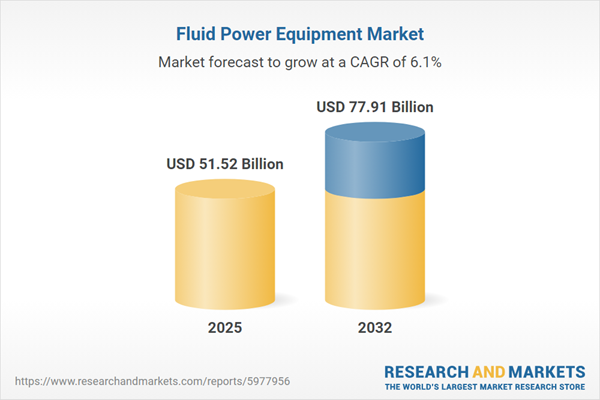Speak directly to the analyst to clarify any post sales queries you may have.
Senior executives seeking to lead in the evolving fluid power equipment market must address shifting regulations, modernization trends, and heightened sustainability pressures. Navigating these challenges requires informed strategies and actionable insight for long-term organizational relevance and growth.
Market Snapshot: Fluid Power Equipment Market Growth
The global fluid power equipment market is expected to expand from USD 48.49 billion in 2024 to USD 51.52 billion in 2025, ultimately reaching USD 77.91 billion by 2032 with a CAGR of 6.10%. This steady progression reflects robust investment across manufacturing, construction, aerospace, and energy sectors, where automation and heightened process efficiency are key catalysts. Suppliers are integrating advanced automation and digital solutions to address increasingly complex operational needs, enhance equipment performance, and provide reliable system uptime. As sustainability now guides product innovation, companies are aligning development with stringent environmental standards. Digital transformation is also playing a crucial role in equipping organizations with the agility to adjust product offerings to suit evolving regulatory and customer expectations in global markets.
Scope & Segmentation of the Fluid Power Equipment Market
This analysis enables senior leaders to optimize investments and operational strategies within the fluid power equipment market. Detailed segmentation supports executive-level decisions by clarifying where value emerges across products, industries, applications, and regions.
- Product Types: Hydraulic accumulators, cylinders, motors, pumps, and high-precision valves facilitate flexible deployment for both new infrastructure and retrofit projects, ensuring efficient and adaptive operations in various sectors.
- End User Industries: Aerospace, automotive, construction, energy and power, food and beverage, manufacturing, mining, and oil and gas each set distinct performance and compliance benchmarks that drive tailored technology solutions.
- Component Types: Single acting, double acting, and telescopic cylinders, in conjunction with gear, piston, and vane motors, underpin system control, equipment dependability, and uninterrupted operation.
- Pressure Levels: High, medium, and low-pressure assemblies address diverse industrial and infrastructure requirements, supporting both established and emerging applications globally.
- Regions: The Americas, Europe, Middle East & Africa, and Asia-Pacific each reveal localized drivers, regulatory frameworks, and supply dynamics that influence market participation and expansion strategies.
- Key Companies: Profiles of leading organizations—including Parker-Hannifin Corporation, Eaton Corporation plc, Bosch Rexroth AG, Danfoss A/S, Hydac International GmbH, Moog Inc., HAWE Hydraulik SE, Kawasaki Heavy Industries, Ltd., Nachi-Fujikoshi Corp., and Mitsubishi Heavy Industries, Ltd.—demonstrate ongoing advancements shaping the sector’s technical and commercial trajectory.
Key Takeaways for Senior Decision-Makers
- Hydraulic and pneumatic systems are integral to mission-critical applications as they support precise operation and maintain high equipment uptime in demanding industries.
- Advanced digital monitoring and analytics tools are increasingly embedded, making predictive maintenance and comprehensive oversight routine in manufacturing and industrial settings.
- Expanding investment in sustainability initiatives ensures ongoing compliance with evolving regulations and mitigates environmental impact across entire value chains.
- Organizations in regions including North America and Asia-Pacific increase responsiveness to policy and customer shifts by leveraging advanced manufacturing technologies and digital infrastructure.
- Customizable solutions offer operational agility, enabling firms to efficiently meet a spectrum of compliance requirements and performance standards in local and global contexts.
- Collaborative supply chain practices facilitate the adoption of automation and streamline logistics, strengthening the ability to meet objectives related to both efficiency and compliance.
Tariff Impact: U.S. Policies and Global Supply Chain Strategies
Evolving U.S. tariff policies are prompting providers of fluid power equipment to adjust global sourcing and supply chain structures. Organizations are diversifying sourcing, localizing essential supply points, and adopting lean inventory to increase resilience. The integration of automation contributes to operational continuity, positioning businesses to better manage rapidly changing trade conditions and policy uncertainties.
Methodology & Data Sources
This report applies a triangulated methodology, synthesizing technical documentation, public sector records, and insights from executive interviews within the fluid power equipment sector. This ensures a balanced market perspective encompassing technology trends, adoption pathways, and compliance developments.
Why This Report Matters for Fluid Power Equipment Market Leaders
- Comprehensive segmentation and regional analysis empower executive teams to make informed strategic investments and market expansion decisions.
- Cohesive coverage of technology, regulatory, and supply chain drivers supports the early recognition of risks and emerging opportunities.
- Actionable recommendations strengthen innovation and operational efficiency, providing reliable guidance to navigate changing industry benchmarks.
Conclusion
This report equips senior leaders with the critical insights required to refine organizational strategies, enhance operational resilience, and drive sustainable growth in the fluid power equipment industry.
Additional Product Information:
- Purchase of this report includes 1 year online access with quarterly updates.
- This report can be updated on request. Please contact our Customer Experience team using the Ask a Question widget on our website.
Table of Contents
3. Executive Summary
4. Market Overview
7. Cumulative Impact of Artificial Intelligence 2025
Companies Mentioned
The companies profiled in this Fluid Power Equipment market report include:- Parker-Hannifin Corporation
- Eaton Corporation plc
- Bosch Rexroth AG
- Danfoss A/S
- Hydac International GmbH
- Moog Inc.
- HAWE Hydraulik SE
- Kawasaki Heavy Industries, Ltd.
- Nachi-Fujikoshi Corp.
- Mitsubishi Heavy Industries, Ltd.
Table Information
| Report Attribute | Details |
|---|---|
| No. of Pages | 193 |
| Published | October 2025 |
| Forecast Period | 2025 - 2032 |
| Estimated Market Value ( USD | $ 51.52 Billion |
| Forecasted Market Value ( USD | $ 77.91 Billion |
| Compound Annual Growth Rate | 6.1% |
| Regions Covered | Global |
| No. of Companies Mentioned | 11 |









